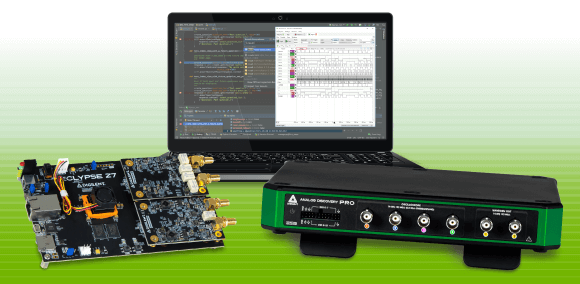In 2021, we brought forward the idea of Embedded Measurement, the name we gave to describe the current convergence of benchtop instruments with the flexibility and agility of embedded systems and FPGA. With April’s Analog Discovery Pro 3000 family along with last year’s Eclypse Z7 and Zmods, we’ve taken initial steps in blurring the lines between FPGA development boards and traditional test devices.

When Did FPGA Become an Option for Testing?
For Digilent, FPGA has always had sort of a “secret handshake” with our test devices. Even way back in the 2000’s, the Digilent Electronic Explorer was introduced featuring a Xilinx Spartan chip, but because of the other features it offered, it was easy to overlook this symbiotic relationship. So why have we chosen to use FPGAs over a different type of processing chip in test and measurement devices? What is it that makes an FPGA so perfect for test engineering?
- Reconfigurability: FPGAs can be reconfigured from their original design, meaning that the way data is processed can be changed in response to new information learned from existing data, or just to accommodate some custom method of working with said data. Reconfigurability is a useful feature to have while doing prototyping. Reconfiguration is also useful in that test & measurement devices can have different “personalities” or “flavors”, and therefore can have unique functionality patched in.
- Deployment: FPGAs can add a layer of easily customizable data processing for a product’s deployment. FPGAs are a cost-effective way to do this processing in a flexible manner, before it even reaches the memory. They’re cheaper than application-specific integrated circuits (ASICs), which have massive up-front investment costs, and faster and (often) lower power than running the same kinds of operations in a processor.
- SoCs: SoCs (systems-on-chip) also add a processor and additional physical interface hardware to the FPGA. The processor lets you run software efficiently on the device. This even includes the ability to run a Linux OS, adding quick and easy support for a lot of software that would otherwise require potentially years of effort to reimplement to run on your device. The physical interface hardware lets you use your FPGA resources on something other than implementing an ethernet controller, making it possible to add ethernet support and work around the restriction of USB transfer speeds.
Why Are FPGA-Based Solutions Becoming More Necessary for Test & Measurement?
As the greater technology landscape is migrating toward IoT applications and real-time measurements, the necessity of being able to measure much higher speeds with even greater accuracy is growing more important. With low latency and the ability to work and process in parallel, FPGAs and SoCs have proven to be the perfect answer to these measurement needs and enables the engineer to utilize digital signal processing. FPGAs are being used extensively in new instrumentation designs, from general purpose test and measurement products to more application-specific instruments in medical, semiconductor, aerospace, and other industries. By moving the decision making closer to the sensor, or at the “edge” of computing, these measurements can be done in a more responsive way, reducing the overhead demands of a test system.
In Digilent’s newer devices like the ADP3450 and Eclypse, the engineer is able to access Linux straight from the device as a result of the System-on-Chip (SoC) at the core. Both use Xilinx’s Zynq technology, and give the user the freedom to draw on software expertise in creating the test system, rather than relying solely on manipulating the hardware, or requiring a USB-connected host computer to do the bulk of the data processing.
How Software Fits In
If FPGAs and Test & Measurement products are separate but complementary technologies, software is the conduit that maximizes their efficiency. Using Linux in designing a prototype gives engineers the ability to program and script automated testing using languages like Python, C++, and MATLAB. At the same time, additional software (like our WaveForms) allows the acquisition, processing, visualization, and management of measurement data and results. In the end, using products that are optimized to take advantage of the benefits of both FPGA and software give the advantage of prototyping, researching, or conducting test functions in a complete hardware-software system.


I would LOVE to see an update on the PYNQ Eclypse-Z7 product. After viewing the demonstration of the RFSoC with PYNQ, I can see so many ways that this interesting environment inspires the many dimensions that this product can be used. I URGE Digilent to revisit the existing port of PYNQ and allow their users that are working to learn the utility of PYNQ (as I am) a helping hand. I LOVE Digilent! Now that Digilent is a part of NI, I would hope there are additional resources that can be added to this dimension. I’ve been a fan and a customer of Digilent from there very first when, as a post-academic (working engineer) I wasn’t able to order because the Digilent initially was for academic purposes focusing on Xilinx. Now, it has become one of my key go-to candy stores.
What this man said, I agree! – Digilent is not just a hardware company. Its an educational company that sells hardware of extreme complexity with support for novice/industral users alike.. The entire value proposition of this company VS random SBC makers: is hardware+ software support, educational support, project support and more. I’ve learned the basics using Digilent and then upgraded to other digilent products for development. But their are still aspects of FPGA technology I have to learn. WELL DOCUMENTED Example Projects, Jupiter Notebook with examples please. It’s great but I think this company could do more in terms of helping users understand the use cases of FPGA technology over other computing devices.